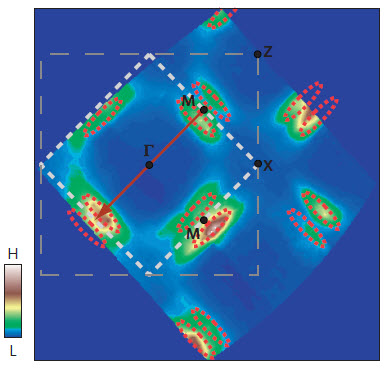Reducing the heat generated by the billions of transistors in computers
June 17, 2015

Fermi surface and band structure of a form of iridium oxide (credit: Junfeng He et al./Nature Materials)
An exotic property that could warp the electronic structure of a material to reduce heat buildup and improve performance in ever-smaller computer components has been observed for the first time in X-ray studies with at the Stanford Synchrotron Radiation Lightsource (SSRL) at the Department of Energy’s SLAC National Accelerator Laboratory.
Heat is an obstacle to packing more computing power into ever-smaller devices; excess heat can cause devices to fail or sap their efficiency.
The research was conducted, in part, at a DOE Office of Science User Facility, and published in the June print edition of Nature Materials.
Energy-bending Properties

This sequence of images, used to illustrate an exotic electronic property observed in a type of iridium oxide, shows the water level in the cup eventually appear to drop as hot water is added to the cup. This effect is caused by the deformation of the cup. Similarly, researchers have found evidence for a property known as 3-D negative electronic compressibility that allows the material’s energy structure to deform. The effect could be useful for designing new semiconductor components that reduce heat and allow miniaturization. (credit: Boston College)
The team studied a form of iridium oxide, Sr3Ir2O7, that belongs to a class of “correlated materials” in which electrons can be made to behave in sync. It is a candidate for reducing the heat generated by the billions of transistors at the core of modern computers.
The researchers discovered that the material has a long-theorized property, formerly found only in 2-D materials and known as 3-D negative electronic compressibility, that is caused by its unusual electronic structure.
The electronic structure of a material is typically rigid, with distinct energy levels or “bands” that fill up as electrons are added. These levels are determined by the atomic structure and chemical composition of the material. In the study, these energy levels were observed to deform drastically, in a fluid way, as more electrons poured in, while the physical structure of the material did not change in any significant way.
“Imagine pouring water into a cup and watching the water level in the cup appear to dip as the cup deforms,” said Junfeng He, a Boston College researcher who led the study. “That’s how 3-D negative electronic compressibility appears to operate.” But in this case, it is the material’s electronic structure – which defines how it can store or flow electric current – rather than its physical structure that substantially warps as electrons are added.
Guided by theoretical calculations led by Arun Bansil, a professor of physics at Northeastern University, researchers found that a gap between different groupings of energy bands in the sample material actually shrank as electrons were added, reducing the material’s stored energy level — like the water level appearing to decline in the cup example.
In principle, using metal electrodes that have this property in the microscopic gates that regulate the flow of electrons in transistors could substantially enhance their efficiency and reduce heat buildup, said He.
Building a Better Transistor
Rui-Hua He, an assistant professor of physics at Boston College who is a spokesperson for the research, notes that replacing normal metals in transistors with materials like this that have negative electronic compressibility “presents an intriguing alternative to current approaches, with a goal of continuing device miniaturization. We are now working on the first demonstration of their potential application to transistors.”
The researchers employed an advanced X-ray technique to precisely measure the electronic structure of the material. The negative electronic compressibility they found shows promise for reducing power requirements needed to move electric current around a semiconductor, for example, which would reduce the heat it generates and make electrical switching more efficient.
Previous studies had observed a 2-D version of negative electronic compressibility in other materials, but researchers said the 3-D form has greater potential for application in semiconductors because it is more compatible with their present-day architecture, can potentially be used at room temperature, and can be adapted for different applications by adjusting its thickness.
Other participating researchers were from SLAC’s SSRL and Stanford Institute for Materials and Energy Sciences (SIMES), Lawrence Berkeley National Laboratory, Peking University in China, Hiroshima Synchrotron Radiation Center in Japan, and the University of California, Santa Barbara. The work was supported by Boston College, the U.S. National Science Foundation, the W. M. Keck Foundation and the DOE Office of Basic Energy Sciences.
Abstract of Spectroscopic evidence for negative electronic compressibility in a quasi-three-dimensional spin–orbit correlated metal
Negative compressibility is a sign of thermodynamic instability of open or non-equilibrium systems. In quantum materials consisting of multiple mutually coupled subsystems, the compressibility of one subsystem can be negative if it is countered by positive compressibility of the others. Manifestations of this effect have so far been limited to low-dimensional dilute electron systems. Here, we present evidence from angle-resolved photoemission spectroscopy (ARPES) for negative electronic compressibility (NEC) in the quasi-three-dimensional (3D) spin–orbit correlated metal (Sr1−xLax)3Ir2O7. Increased electron filling accompanies an anomalous decrease of the chemical potential, as indicated by the overall movement of the deep valence bands. Such anomaly, suggestive of NEC, is shown to be primarily driven by the lowering in energy of the conduction band as the correlated bandgap reduces. Our finding points to a distinct pathway towards an uncharted territory of NEC featuring bulk correlated metals with unique potential for applications in low-power nanoelectronics and novel metamaterials.